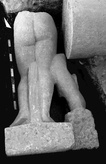- FundeFigs. IV. 20-25
Figs. IV. 20-25
Jerash, Department of Antiquities, no inv., excavation nr. 2016-7.
From Gerasa / Jerash, found on May 7th, 2016 south of the southern stylobate of the north hall in a destruction level of room M (square 77), deposited in north-southern extension lying upon the abdomen. The calves, feet and pedestal were uncovered in the adjacent square until May 11th when the torso was lifted and extracted from the trench with the help of a crane. Subsequently, the fragment was deposited on the Antiquities site in front of the museum.
White crystalline marble of fine to medium grain.
The entire upper body with head and both arms is broken away, also both extended arms, head and rounded upper edge of the Eros left wing, as well as the tail of the dolphin. The partly flaked fingers of the left hand gasping the towel are preserved, the rest of the hand as well as the entire arm are lost. At the left hip remains a trunk of a horizontal support which stabilized the lost lower arm underneath the bent elbow. Smaller bruises upon the ridges of the drapery, otherwise well preserved. The entire surface is covered by a soft and reversible stained yellowish-brown patina, preliminarily cleaned after removal from the trench. Few traces of greyish sinter.
H 164.3 cm. W of pedestal 87 cm; D of pedestal 51 cm.
The depicted attire is that of the naked goddess, upright standing in relaxed stance, surprised while bathing, pulling a large towel from between the closed legs of her relaxed stance upward with her lowered left hand in order to cover shamefully her private parts from the lascivious eyes of an hidden spectator. Beside her right leg, a boyish winged nude Eros is riding a jumping dolphin. Both arms and the head are lost, but it appears that he cheerfully lifted his right and while grasping the dolphin’s fin with his left hand. The mammal holds an octopus in its beak grasping it between the tentacles and the ink sack head. The goddesses’ feed stand almost parallel to each other and the thigh of the relaxed left leg is slightly advancing forward. The towel drawn by her left hand is falling in cascades of drapery in front of her left leg. The arrangement of the textile compartments displays despite its three-dimensional depth a certain schematism of the vertical channels separating the compartments of fabric from each other. All under-cuttings and grooves have been carved by the pointed chisel. There is no evidence for the application of the running drill.
On the frontal face of the pedestal a Greek inscription in four lines. The third line continues on an adjacent curved segment of the left side, above two additional lines in Greek naming the year, the month and the day of the statue’s inauguration
Text 1 (reading by P.-L. Gatier):
Ἀγάθηι Τύχηι (hedera). Ὑπὲρ σωτηρίας τοῦ κυρίου
Ἀυτοκράτωρος Δημήτριος Ἀσκληπιωδώρου
κατὰ δὲ υἱοθεσίαν τὴν Ἀφροδίτην σὺν τῇ βάσει κ(αὶ) κόνχῃ καὶ
βωμῷ σὺν ἑστίᾳ ἱερώμενος ἐφιλοτιμήσατο.
Translation (by P.-L. Gatier):
“To the good fortune. For the welfare of the Lord,
The Emperor, Demetrios, [son of] Asklepiodoros
by adoption donated as a priest [the statue of]
Aphrodite with the base and the niche and the altar with fire place.”
Apparatus criticus and comment (by P.-L. Gatier):
Inscription field 64 x 23 cm. Narrow alphabet according to C. B. Welles’ classification with small omikron and several ligatures. Line 4 continues as line 4 on the right lateral side of the plinth., H of the letters (the smallest like omikon and the largest phi: 3.5–5 cm There are many paralleles among other inscriptions from Gerasa for the single aspects communicated in this new inscription: For the families of Asklepiodoros and Demetrios: C. B. Welles, in: Kraeling 1939, nos. 10 and 123; for the adoption: C. B. Welles, in: Kraeling 1939, no. 187; for the way to indicate the duty of the priesthood without precision to the cult which might have that of the Roman Emperor: C. B. Welles, in: Kraeling 1939, nos. 15. 121 and 122.
Text 2 (reading by P.-L. Gatier):
Ἔτους ιϚσ’
Ξανδικοῦ κ’
Translation (by P.-L. Gatier):
“Year 216,
Xandikos 20”
Apparatus criticus and comment (by P.-L. Gatier):
Curved small inscription field 11 x 23 cm. Inscription in three lines of which line 3 continues line 4 of text 1 on the frontal face of the plinth. The counting system of the year is rare, it start with tens, single units, and hundreds: The first letter means 10, the second 6, and the third 200. The statue is thus dated by this inscription to the 20th day in the Macedonian month Xandikos (scil.: Xanthikos) of the year 216 in the era of Gerasa, i. e. to March 20th, 154 AD as a terminus post quem non, early Antonine, reign of Antoninus Pius.
Bibl.: unpublished






